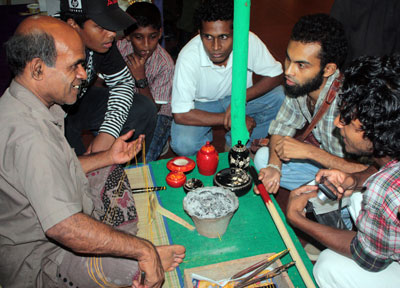Micro finance as a tool of poverty alleviation; not for private profit
The writer was the pioneer in commencing best practice micro finance in Sri Lanka, through the establishment of SEEDS in 1986 which went on to assist over 300,000 families. In the past microfinance was purely a tool for poverty alleviation and women’s empowerment.

File picture of a craftsman explaining his artistic work at a recent exhibition. Craftsmen like this rely on micro finance to sustain their business.
However there are a significant number of organisations having social development as the first objective of microfinance. The main element of such organisations are lending at low and affordable interest rates. The loan sizes are kept small to ensure the poor do not go after money eagerly. Working with the community on other social needs and empowering them are other important elements. Providing ‘credit plus’ or training in business is another feature. Although some such MFIs (micro finance institutions) are legally profit-making companies due to requirements for taking foreign loans or to obtain a microfinance licence from the Central Bank, they remain in the social objectives as the core. The Lanka Microfinance Practitioners’ Association (LMFPA)’s microfinance reviews indicate that there were 87 per cent not for profit MFIs in 2012 where its percentage has reduced to 47 per cent in 2016 because of increased profit oriented finance companies starting microfinance and the commencement of number of profit oriented MFIs in the last 4 – 5 years.
Two examples of socially oriented MFIs are given below: Berendina
Berendina’s history in Sri Lanka goes back to 1986. Berendina is a development organisation having a separate company for microfinance started in 2007, serving over 100,000 families. It lends at an average flat interest rate of 14 per cent per annum and had a profit after tax of Rs.100 million in 2017. Those profits were used for further loans and also to partly fund the other two grant-based NGOs in Berendina for their free services for various forms of vulnerable poor including youth and children.
Berendina is the only agency carrying out a demand-driven credit plus programme. Clients are given an opportunity to follow training in any aspect of business management, in technology (agriculture-related) and in soft skills at a very reasonable fee. Over 45,000 people were trained in 2017. Further, clients are provided with loan write-off in the event of death, full disability and severe sickness of the borrower or the spouse.
There is scientific evidence (PPI data) that a significant number of people reduce their poverty level every year. For example 6,864 families increased their income level by 2017 from US$2.5 a day (PPP 2005) level where they were in 2015. From another scientific research it was found that each 100 income generation loans given has created or supported 77 full time and 31 part time/seasonal employments after accounting the failure rate of 14 per cent businesses in income generation loans.
Hambantota Women’s Development Federation (WDF)
WDF is a NGO, purely owned by 80,000 poor women in Hambantota and Moneragala districts who are also the managers and clients of the organisation. It is also a registered microfinance NGO under the microfinance Act of Sri Lanka. WDF started in 1989 and is now 30 year’s old and a highly respected organisation. Its microfinance includes a whole range of financial services such as savings, credit and micro insurance. It has Rs. 1.2 billion rupees as savings of poor women. Its loan portfolio is Rs. 1.3 billion. Its insurance fund is Rs. 191 million. It has made Rs.105 million after tax profit in 2017. WDF made this profit by charging an interest rate of 24 per cent declining (converted flat rate 13 per cent).
The women empowerment is core to the organisation. Microfinance is only one major tool they use in achieving the empowerment objective. Of the 80,000 women members 79 per cent have reached self-employment or above having a secured economic base of the women for these families. 36 per cent of these economically empowered women are above self-employment having an enterprise making additional employment for village people.
The organisation’s other strategies for women empowerment are training and capacity building, alcohol and drug prevention programmes, ensuring women and child rights. In the declined donor funding environment for this type social work, WDF managed these large programmes with the profits they make from microfinance in a strongly sustainable manner.
Hence what is necessary is not to bash micro finance but to create policies which enable the poor to access capital at a reasonable interest rate and allow them for convenient and secure savings of small surpluses which they need as much as the rich. Given the high interest rates such as 20 per cent or even 30 per cent flat per annum charged by profit oriented MFIs the government move to bring an interest rate cap of 35 per cent is a good move in this direction although the above two examples shows 35 per cent (effective) is also much higher than a rate which can generate reasonable profit for a MFI.
One should not assume that these socially oriented MFIs are profitable because of donor funds which were not available for microfinance for more than 7-8 years at least in Sri Lanka. Although NGOs are now regulated under the Microfinance Act of 2016 it is a serious concern that the Central Bank could not do its part in regulating the microfinance companies. Having a large number of MFIs for Central Bank regulation is not required but make a small number eligible regulated and allow them to grow strong which will no doubt help protect the poor from money-sharks under the guise of microcredit companies.
(The writer is the former Chairman of Berendina Group and present Chairman of Give2Lanka and can be contacted on dulande@gmail.com )


